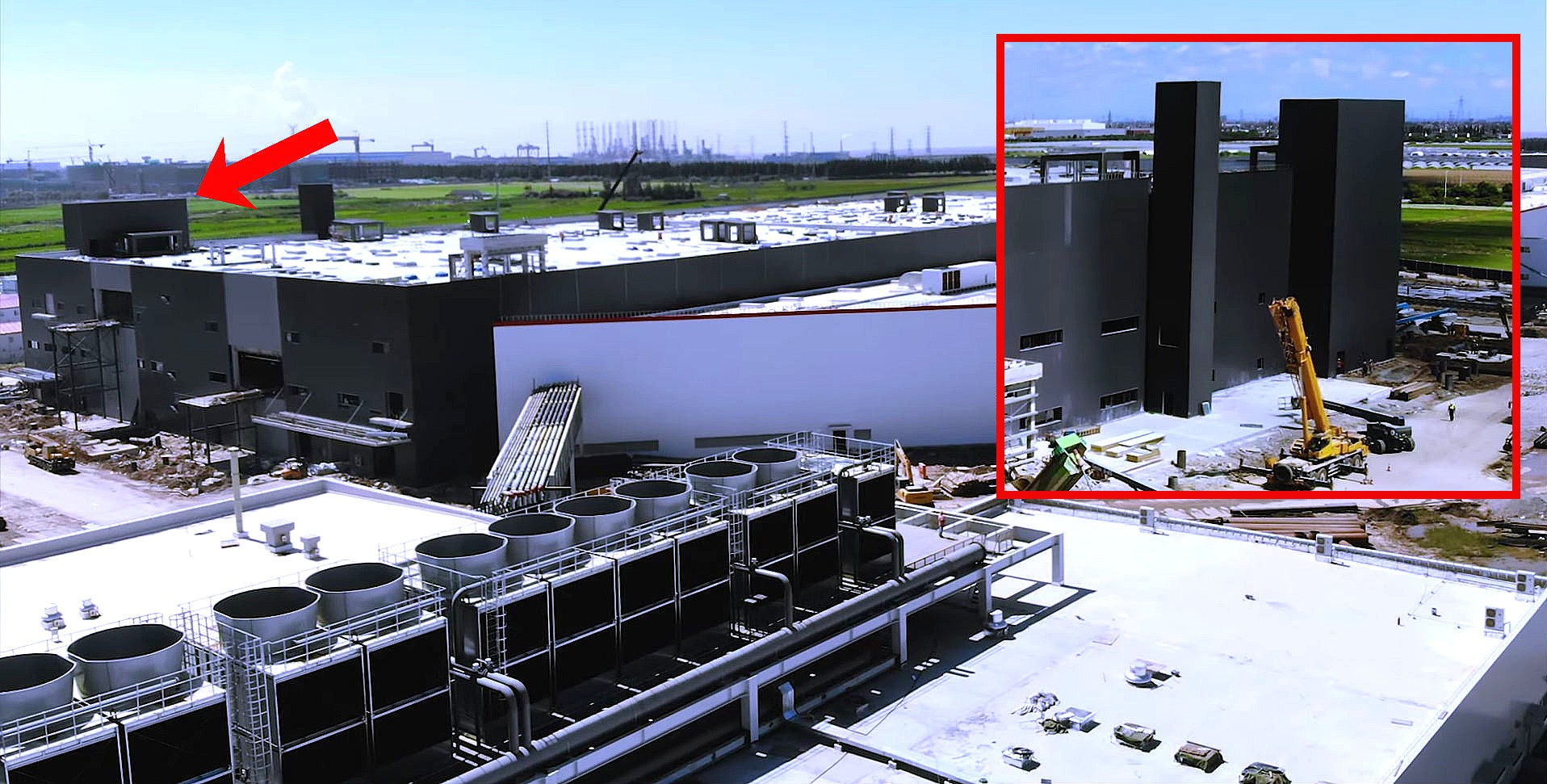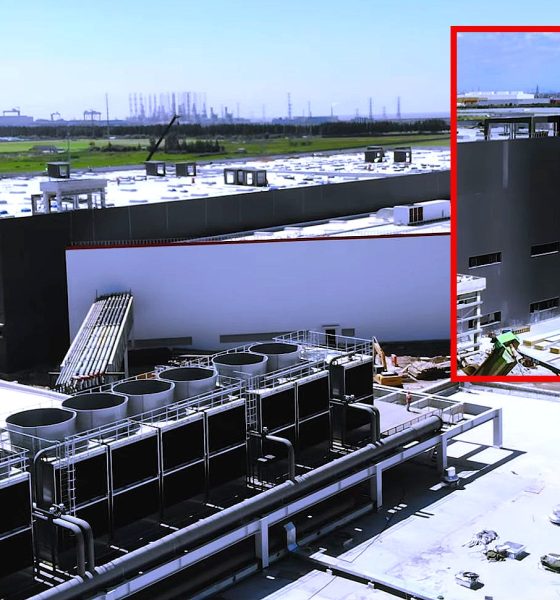

News
Tesla Gigafactory 3 gets ‘Space Odyssey’ Monolith-like structure amid buildout
The buildout of Tesla’s Gigafactory 3 in Shanghai continues to be impressive, with the facility and its surrounding complex showing more progress with every new update. This is particularly evident in the site’s general assembly building, which is looking more and more like one of Tesla’s iconic factories in the United States. Interestingly enough, workers in Gigafactory 3 have begun building a couple of structures at the northern end of the facility, both of which are notably taller than the rest of the main factory.
The structures became evident in recent drone flyovers, particularly as workers began covering the final exposed portions of Gigafactory 3. Neither Tesla China nor local news agencies have revealed what the tall structures are, though, their height suggests that they might be used as towers (perhaps for elevators?) for the electric vehicle production facility.
With the Tesla community being familiar with Elon Musk’s love of science fiction, some promptly observed that the structures looked strangely similar to the Monoliths in Arthur C. Clarke’s Space Odyssey series. One of the towers definitely looks the part, from its solid black paint to its overall proportions. Whether the tower’s design is but a coincidence or yet another Easter Egg from Elon Musk will likely remain unknown, but it is difficult to deny that the structures are a nice touch to the massive facility.
The Monoliths are among the most notable structures in the Space Odyssey series. Varying in size but always always taking the form of a mysterious black slab, the Monoliths are capable of many different functions. TMA-0, a Monolith discovered in Africa, was even described in the franchise’s lore as the catalyst for evolution. All the Monoliths in Clarke’s world maintain a 1:4:9 dimensional ratio, which does not seem to be true for the tower in Gigafactory 3. Then again, it is not too difficult to imagine Elon Musk or the Tesla team adding the monolithic towers at Gigafactory 3 as a fun, lighthearted reference to the iconic sci-fi series. Such would be on-character for Tesla, being a carmaker whose vehicles’ volumes go up to 11 (a reference to This is Spinal Tap), and whose mobile app has a Back to the Future Easter Egg.
Potential Easter Eggs and sci-fi references aside, Gigafactory 3 continues to be built at a rapid rate. The site continues to enjoy notable support from the government, as shown by the close monitoring of Gigafactory 3’s progress by high-ranking officials. Less than two weeks ago, the Gigafactory 3 complex was graced by Shanghai Party Secretary Li Qiang, and more recently, reports have also mentioned that the Shanghai Mayor paid a visit to Tesla’s construction site. Local news agencies have also reported that Tesla’s first batch of Gigafactory 3 employees are expected to start their work at the facility by the end of July.
Tesla CEO Elon Musk expects Gigafactory 3 to start the initial production of the Model 3 before the end of the year. While this is already very ambitious considering that the facility only broke ground in January, reports from China have pointed to the possibility of initial Model 3 production beginning as early as September, barring any unexpected delays. Chinese media appears to be supporting this narrative, and based on images of Gigafactory 3 that were shared by Tesla in its update letter, a September initial run for the Model 3 might be more feasible than expected.
Watch the latest flyover of Tesla’s Gigafactory 3 complex in the video below.

News
Tesla FSD fleet is nearing 7 billion total miles, including 2.5 billion city miles
As can be seen on Tesla’s official FSD webpage, vehicles equipped with the system have now navigated over 6.99 billion miles.

Tesla’s Full Self-Driving (Supervised) fleet is closing in on almost 7 billion total miles driven, as per data posted by the company on its official FSD webpage.
These figures hint at the massive scale of data fueling Tesla’s rapid FSD improvements, which have been quite notable as of late.
FSD mileage milestones
As can be seen on Tesla’s official FSD webpage, vehicles equipped with the system have now navigated over 6.99 billion miles. Tesla owner and avid FSD tester Whole Mars Catalog also shared a screenshot indicating that from the nearly 7 billion miles traveled by the FSD fleet, more than 2.5 billion miles were driven inside cities.
City miles are particularly valuable for complex urban scenarios like unprotected turns, pedestrian interactions, and traffic lights. This is also the difference-maker for FSD, as only complex solutions, such as Waymo’s self-driving taxis, operate similarly on inner-city streets. And even then, incidents such as the San Francisco blackouts have proven challenging for sensor-rich vehicles like Waymos.
Tesla’s data edge
Tesla has a number of advantages in the autonomous vehicle sector, one of which is the size of its fleet and the number of vehicles training FSD on real-world roads. Tesla’s nearly 7 billion FSD miles then allow the company to roll out updates that make its vehicles behave like they are being driven by experienced drivers, even if they are operating on their own.
So notable are Tesla’s improvements to FSD that NVIDIA Director of Robotics Jim Fan, after experiencing FSD v14, noted that the system is the first AI that passes what he described as a “Physical Turing Test.”
“Despite knowing exactly how robot learning works, I still find it magical watching the steering wheel turn by itself. First it feels surreal, next it becomes routine. Then, like the smartphone, taking it away actively hurts. This is how humanity gets rewired and glued to god-like technologies,” Fan wrote in a post on X.
News
Tesla starts showing how FSD will change lives in Europe
Local officials tested the system on narrow country roads and were impressed by FSD’s smooth, human-like driving, with some calling the service a game-changer for everyday life in areas that are far from urban centers.

Tesla has launched Europe’s first public shuttle service using Full Self-Driving (Supervised) in the rural Eifelkreis Bitburg-Prüm region of Germany, demonstrating how the technology can restore independence and mobility for people who struggle with limited transport options.
Local officials tested the system on narrow country roads and were impressed by FSD’s smooth, human-like driving, with some calling the service a game-changer for everyday life in areas that are far from urban centers.
Officials see real impact on rural residents
Arzfeld Mayor Johannes Kuhl and District Administrator Andreas Kruppert personally tested the Tesla shuttle service. This allowed them to see just how well FSD navigated winding lanes and rural roads confidently. Kruppert said, “Autonomous driving sounds like science fiction to many, but we simply see here that it works totally well in rural regions too.” Kuhl, for his part, also noted that FSD “feels like a very experienced driver.”
The pilot complements the area’s “Citizen Bus” program, which provides on-demand rides for elderly residents who can no longer drive themselves. Tesla Europe shared a video of a demonstration of the service, highlighting how FSD gives people their freedom back, even in places where public transport is not as prevalent.
What the Ministry for Economic Affairs and Transport says
Rhineland-Palatinate’s Minister Daniela Schmitt supported the project, praising the collaboration that made this “first of its kind in Europe” possible. As per the ministry, the rural rollout for the service shows FSD’s potential beyond major cities, and it delivers tangible benefits like grocery runs, doctor visits, and social connections for isolated residents.
“Reliable and flexible mobility is especially vital in rural areas. With the launch of a shuttle service using self-driving vehicles (FSD supervised) by Tesla in the Eifelkreis Bitburg-Prüm, an innovative pilot project is now getting underway that complements local community bus services. It is the first project of its kind in Europe.
“The result is a real gain for rural mobility: greater accessibility, more flexibility and tangible benefits for everyday life. A strong signal for innovation, cooperation and future-oriented mobility beyond urban centers,” the ministry wrote in a LinkedIn post.
News
Tesla China quietly posts Robotaxi-related job listing
Tesla China is currently seeking a Low Voltage Electrical Engineer to work on circuit board design for the company’s autonomous vehicles.

Tesla has posted a new job listing in Shanghai explicitly tied to its Robotaxi program, fueling speculation that the company is preparing to launch its dedicated autonomous ride-hailing service in China.
As noted in the listing, Tesla China is currently seeking a Low Voltage Electrical Engineer to work on circuit board design for the company’s autonomous vehicles.
Robotaxi-specific role
The listing, which was shared on social media platform X by industry watcher @tslaming, suggested that Tesla China is looking to fill the role urgently. The job listing itself specifically mentions that the person hired for the role will be working on the Low Voltage Hardware team, which would design the circuit boards that would serve as the nervous system of the Robotaxi.
Key tasks for the role, as indicated in the job listing, include collaboration with PCB layout, firmware, mechanical, program management, and validation teams, among other responsibilities. The role is based in Shanghai.
China Robotaxi launch
China represents a massive potential market for robotaxis, with its dense urban centers and supportive policies in select cities. Tesla has limited permission to roll out FSD in the country, though despite this, its vehicles have been hailed as among the best in the market when it comes to autonomous features. So far, at least, it appears that China supports Tesla’s FSD and Robotaxi rollout.
This was hinted at in November, when Tesla brought the Cybercab to the 8th China International Import Expo (CIIE) in Shanghai, marking the first time that the autonomous two-seater was brought to the Asia-Pacific region. The vehicle, despite not having a release date in China, received a significant amount of interest among the event’s attendees.








